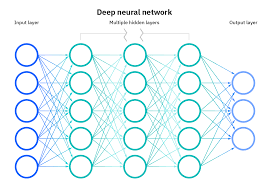Exploring the Power of Optical Neural Networks
In recent years, the field of artificial intelligence has seen significant advancements with the emergence of optical neural networks. This cutting-edge technology combines the principles of traditional neural networks with the speed and efficiency of optics, opening up new possibilities for faster and more energy-efficient computing.
Optical neural networks leverage light-based signals to perform complex computational tasks in parallel, mimicking the way neurons in the human brain process information. By using light instead of electrical signals, these networks can achieve higher processing speeds and lower power consumption compared to conventional electronic systems.
One key advantage of optical neural networks is their ability to handle massive amounts of data in real time. This makes them well-suited for applications such as image recognition, natural language processing, and autonomous driving, where quick decision-making is crucial.
Researchers are actively exploring various architectures and designs for optical neural networks to optimize their performance and scalability. By integrating photonics components with traditional electronic hardware, they aim to create hybrid systems that combine the best of both worlds.
As optical neural networks continue to evolve, they hold great promise for revolutionizing fields such as deep learning, computer vision, and data analytics. With their speed, efficiency, and scalability, these innovative systems are poised to shape the future of artificial intelligence and drive new breakthroughs in technology.
Understanding Optical Neural Networks: Key Questions and Insights
- What is an optical neural network?
- How does an optical neural network differ from a traditional neural network?
- What are the advantages of using optics in neural networks?
- What applications can benefit from optical neural networks?
- Are there any challenges associated with implementing optical neural networks?
- How do optical neural networks process information differently from electronic systems?
- What research is currently being conducted in the field of optical neural networks?
- How do optical neural networks contribute to advancements in artificial intelligence?
What is an optical neural network?
An optical neural network is a cutting-edge technology that harnesses the power of light to perform complex computational tasks in parallel, inspired by the way neurons in the human brain process information. By utilizing light-based signals instead of traditional electrical signals, optical neural networks offer faster processing speeds and reduced energy consumption. This innovative approach combines the principles of traditional neural networks with the efficiency of optics, paving the way for advancements in artificial intelligence, image recognition, natural language processing, and other data-intensive applications that require real-time decision-making capabilities.
How does an optical neural network differ from a traditional neural network?
An optical neural network differs from a traditional neural network in the way it processes information. While traditional neural networks rely on electrical signals to transmit and process data, optical neural networks use light-based signals for computation. This fundamental difference allows optical neural networks to achieve higher processing speeds and lower energy consumption compared to their electronic counterparts. By leveraging the speed and parallel processing capabilities of optics, optical neural networks offer a promising alternative for tasks that require fast decision-making and handling of large datasets, paving the way for more efficient and powerful computing systems in the field of artificial intelligence.
What are the advantages of using optics in neural networks?
The advantages of using optics in neural networks lie in their ability to harness the speed and efficiency of light-based signals for high-performance computing. By leveraging optics, neural networks can achieve faster processing speeds and lower energy consumption compared to traditional electronic systems. This enables them to handle large volumes of data in real time, making them ideal for applications requiring rapid decision-making, such as image recognition and natural language processing. Additionally, optical neural networks have the potential to revolutionize fields like deep learning and data analytics by offering scalable and parallel processing capabilities that can significantly enhance overall performance and computational efficiency.
What applications can benefit from optical neural networks?
Optical neural networks offer a wide range of applications that can benefit from their unique capabilities. Industries such as image recognition, natural language processing, autonomous driving, and healthcare stand to gain significant advantages from the speed, efficiency, and parallel processing capabilities of optical neural networks. These systems excel in tasks that require real-time data processing, high computational power, and low energy consumption. By leveraging light-based signals for computation, optical neural networks can revolutionize fields like deep learning, computer vision, and data analytics, opening up new possibilities for faster and more advanced artificial intelligence solutions.
Are there any challenges associated with implementing optical neural networks?
Implementing optical neural networks presents several challenges that researchers and developers need to address. One of the key challenges is integrating optical components with existing electronic systems to create hybrid architectures that can effectively harness the speed and efficiency of light-based processing. Another challenge lies in optimizing the performance and scalability of optical neural networks, ensuring they can handle complex computational tasks while maintaining high accuracy and reliability. Additionally, issues related to signal noise, crosstalk, and signal loss in optical systems need to be mitigated to achieve robust and stable operation. Overcoming these challenges requires innovative solutions and interdisciplinary collaborations to unlock the full potential of optical neural networks in advancing artificial intelligence technologies.
How do optical neural networks process information differently from electronic systems?
Optical neural networks process information differently from electronic systems by leveraging light-based signals instead of traditional electrical signals. This fundamental difference enables optical neural networks to perform computations in parallel, mimicking the parallel processing capabilities of the human brain more closely. By harnessing the speed and efficiency of optics, these networks can achieve higher processing speeds and lower power consumption compared to conventional electronic systems. This unique approach allows optical neural networks to handle massive amounts of data in real time, making them well-suited for applications requiring quick decision-making, such as image recognition and natural language processing.
What research is currently being conducted in the field of optical neural networks?
Ongoing research in the field of optical neural networks is focused on exploring novel architectures and designs to enhance their performance and scalability. Researchers are investigating ways to integrate photonics components with traditional electronic hardware to create hybrid systems that leverage the speed and efficiency of optics. Additionally, studies are being conducted to optimize the training algorithms and data processing techniques used in optical neural networks, with the goal of improving their accuracy and reliability for a wide range of applications, such as image recognition, natural language processing, and autonomous systems. By pushing the boundaries of innovation in this rapidly evolving field, researchers are paving the way for exciting advancements in artificial intelligence and computational technology.
How do optical neural networks contribute to advancements in artificial intelligence?
Optical neural networks contribute significantly to advancements in artificial intelligence by providing unprecedented processing speeds and energy efficiency. By using light-based signals instead of traditional electrical ones, these networks can perform complex computations in parallel, allowing for real-time data processing and decision-making. This capability is particularly beneficial for applications requiring rapid analysis and response, such as image recognition, natural language processing, and autonomous systems. Moreover, the reduced power consumption of optical neural networks makes them more sustainable and cost-effective, enabling the development of more powerful AI models without the associated high energy costs. As a result, optical neural networks are paving the way for more efficient and scalable AI solutions that can handle the growing demands of modern technology.



